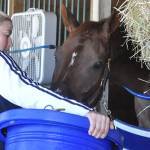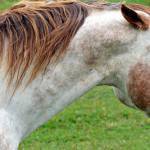Question
I was just informed that my adult gelding’s dam was diagnosed with polysaccharide storage myopathy (PSSM). From what I understand, treating him like he too has the disease will not negatively affect him if he does not. He does have many of the symptoms, so it's my bet that he is affected. I am trying to figure out all of my options as far as feeds go and would like your opinion.
Answer
The Neuromuscular Diagnostic Laboratory at Michigan State University is able to test your horse to definitively determine whether he has polysaccharide storage myopathy (PSSM). Learn more about PSSM on its website. One of the researchers at this lab, Stephanie Valberg, D.V.M., works closely with Kentucky Equine Research (KER) to formulate feeds appropriate for horses with muscle disorders.
Feeding any horse a diet that is appropriate for a horse with PSSM will not hurt the animal and may even help calm a temperamental one; however, it is not the most economical way to feed a horse. If the horse does have PSSM, then this type of diet would be beneficial and should reduce the incidence of symptoms. The aforementioned website gives extremely useful nutritional advice for horses diagnosed with PSSM.
Before I explain the diet, I would just like to emphasize that no dietary change will help if the horse does not have a regular, consistent exercise schedule, preferably one in which he is exercised daily. For some horses, this may be 24-hour turnout, and for others, this may be structured daily exercise such as riding or driving. The important thing to remember: the horse needs to move around.
In general, we recommend the horse receive a limited amount of starch and sugar from the diet. This will mean different things depending on whether the horse is underweight or overweight.
For an overweight horse with PSSM that does not need many additional calories above the forage requirement, a diet could be as simple as a ration balancer (1-2 lb/day) with an additional one-quarter cup of canola oil plus forage. An example of a ration balancer is All-Phase, formulated by KER.
Another option would be 1 lb of hay pellets with one-quarter cup of canola oil and a vitamin/mineral supplement like Micro-Max plus forage. Still another option is forage and Re-Leve Concentrate, which is formulated to be fed at a rate of 3 to 6 lb per day and has all of the protein, vitamins, and minerals your horse requires.
For an underweight horse diagnosed with PSSM, in addition to high-quality forage, the simplest, most effective option is Re-Leve Original, which has a recommended feeding rate of 6 to 12 lb per day depending on the energy needs of the horse and will supply all of the nutrients the horse needs in a very low-starch formula.
Two other, more cumbersome options are available. One option is 1 lb of ration balancer, 2 to 8 lb of hay pellets, and up to 2 cups of oil per day. Rice bran can be used to replace a portion of the oil because it contains 20% fat, is low starch, and contains some good digestible fiber. Another similar option is 4 to 12 lb per day of hay pellets with oil/rice bran and a vitamin/mineral supplement like the Micro-Max.
There are other feed manufacturers that make low-starch and low-sugar feeds, but none has the research behind them to prove their effectiveness with PSSM horses as does Re-Leve, so I hesitate to recommend any of them.








